
table of contents
- Characteristics
- Buy preferred plants
- Location
- floor
- plants
- care
- to water
- Fertilize
- Overwinter
- Cut
- Multiply
- Pests and diseases
Profile and care information open +conclude -
- Flower color
- yellow, red, inconspicuous, green
- Location
- Partial shade, sunny
- Heyday
- April May
- Growth habit
- upright, expansive
- height
- up to 35 meters high
- Soil type
- sandy, loamy
- Soil moisture
- fresh
- PH value
- neutral, weakly alkaline, weakly acidic, alkaline
- Limescale tolerance
- Calcium tolerant
- humus
- rich in humus
- Poisonous
- Yes
- Plant families
- Beech family, Fagaceae
- Plant species
- Deciduous trees, useful plants, ornamental trees
- Garden style
- Natural garden, park, forest garden
The oak is one of the most important trees in Germany. With its characteristic leaves and expansive growth, it has stimulated people's ideas for thousands of years and is of great importance in local customs. Quite a few have an oak tree in their garden or are considering planting a new one and thereby expanding it. Fortunately, the oak is an easy-care tree with outstanding character and robust properties.
Characteristics
- Family: Beech family (Fagaceae)
- upright trees with a large, asymmetrical crown
- Growth height: 15 to 35 meters high
- Leaves: clearly serrated, ovate or oval leaves in an intense green
- Blossom: downward-hanging catkins or spikes in red, green or yellow (depending on the species)
- Flowering period: April to May
- Origin: northern Africa, Europe, Asia, North America, Colombia, Central America, the Caribbean
- frost-sensitive to winter hardy (depending on the species)
- lime tolerant
- summer or evergreen (depending on the species)
Buy preferred plants
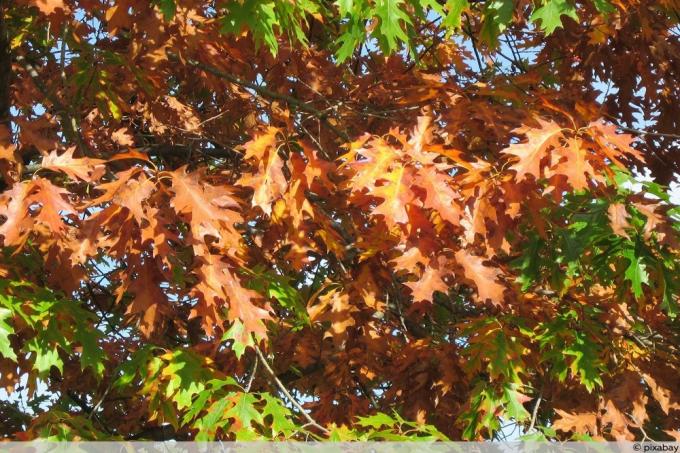
You have decided to plant an oak and are now wondering which species is suitable for the local area? The oak tree is originally a plant from the Mediterranean area that has established itself in the northern hemisphere and is a typical sight there. The leaves in particular draw attention to themselves with their characteristic shape. Due to the origins of the oaks, only a handful of species can be found that are really suitable for planting. These are the taxa that are sufficiently winter hardy:
- English oak (bot. Quercus robur)
- Sessile oak (Quercus petraea)
- Red oak (Quercus rubra)
- Evergreen Oak (Querces turneri)
The winter hardiness of these specimens ranges from -15 ° C for the evergreen to -35 ° C, which makes them ideal for Central European gardens. So if you are looking for a suitable specimen at a nursery or online retailer, you should do more to look for these taxa and varieties. Since oaks are not kept in pots, you should look at the relevant tree in advance, if you want to be sure that it fits into your garden and not from pests infested. Since oaks can be very large and trunk widths of more than ten meters, they should only be planted in sufficiently large gardens. Before you buy, you should check whether the oak would come into contact with the following obstacles:
- building
- Carports
- fences
- Walls
- Lines in the ground
- Foundations
Not only do oaks grow in width and height, but because of the deep taproot it is possible that water pipes or cellars are damaged. Be sure to include these points in your selection. You should also consider your neighbors, as oak trees can quickly cast shade on other properties. Because of their size and shape, oaks are ideal as sun protection.
Note: The cork oak (bot. Quercus suber) is also a popular species, but it is not completely hardy and can only withstand temperatures as low as -5 ° C before it is damaged. For this reason, it is mainly suitable for areas with mild winter, especially the local wine-growing regions and southwest Germany.
Location
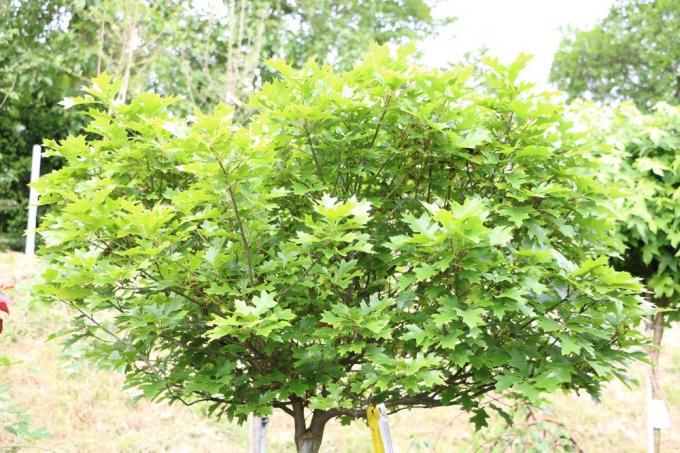
Since the trees can only be transplanted after a few years with a high risk, you should choose a suitable location for them. You can tell from the desired properties that oak is a light tree species:
- Light requirement: sunny to partially shaded
- warm
- open spaces are ideal
- enough space
Wind and precipitation do not really affect the oak tree, as the plants are extremely robust. Because of this, they can actually be planted anywhere, as long as there is enough sun and space. It is also important that the distance to other plants is at least one meter, better still more.
Note: If you live near a large city park or forest, the oak tree will help you animal visitors like numerous birds including the jay, rodents like the squirrel and even Deer. Many of the animals are particularly happy about the nuts in winter.
floor
In addition to the right location, you must not neglect the nature of the soil. The oak tree is counted to the undemanding plants, because it thrives on a variety of soils, but are some properties more suitable for the Quercus species in order to maintain vitality and growth support. These in detail:
- fresh
- rich in minerals
- permeable
- profound
- loamy
- pH value: 5.0 - 10.0
These properties make it clear that oak likes to have moisture and nutrients available. Nevertheless, it thrives splendidly in soils that are not ideal for the oak tree. This includes both dry and compacted soil over a longer period of time. that would cause serious problems for other plants. With such soils, it is important to adjust the care of the trees accordingly and, for example, to water more or to optimize the soil quality through additives. Optimal soil also improves resistance to diseases and pests.
plants
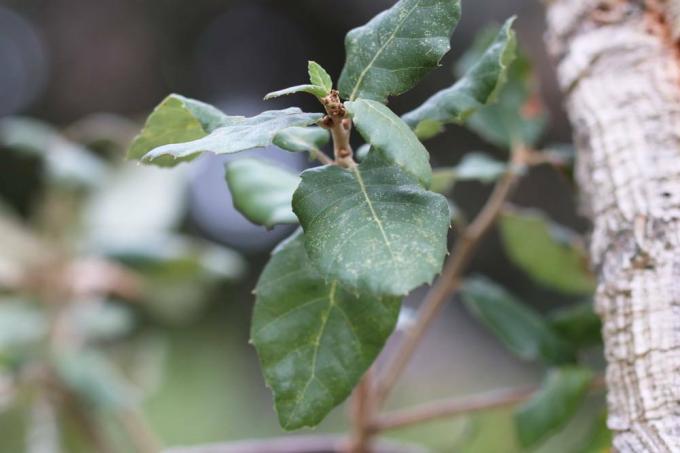
When planting, a few points must be observed, otherwise the tree could be damaged. The time of planting differs depending on the age of the tree. While a young oak tree can be planted in the spring or in the fall before the first frost, it should only be possible to plant adult specimens in the spring. Young trees can establish themselves on the site in a significantly shorter time than the older ones. Also, choose a day when it won't rain. Planting succeeds in the following way:
- Dig up the site well
- Dig the planting hole
- Planting hole width: twice as root ball
- Planting hole depth: at least as taproot
- Create drainage in excessively moist soils
- Drainage material: gravel
- Layer thickness: about 5 cm
- Enrich the excavated earth with leaves or ripe compost
- Carefully place the oak tree in the planting hole
- this must be completely straight
- Taproot must not buckle
- Now fill the planting hole
- trod the earth
- Equip young plants with support stakes
- tie to this
- Pour the soil thoroughly
It is best to use the garden hose to intensively fill the site, as the oak tree needs a lot of moisture. In this way, it easily establishes itself within a short period of time. It is advisable to plant the oak with the help of someone else, especially the larger the specimen. If you are transplanting an old specimen, you should do this with an excavator or with the help of a professional Experts use it to avoid damaging the tree and to move it safely to the new location promote.
Note: It is imperative that you plant a younger specimen because its taproot is not yet as well developed. This reduces the risk of possible damage that could occur during transport or planting.
care
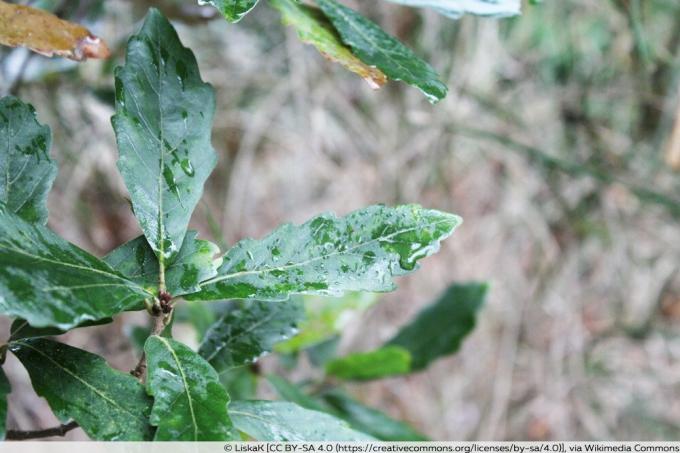
If the oak has been planted or if you have just become the owner of a property with an oak tree, caring for it is an important part of keeping it. Oaks are quite undemanding plants, which in the best case scenario are completely self-sufficient. Watering and fertilizing in particular are very easy and require little effort. On the other hand, the most important aspects of care include pruning and pest control. Depending on the age of the plant, these are extremely different.
to water
An oak tree does well without additional watering as soon as it has established itself on the site. Although the plants always need fresh, moist soil, prolonged drought is not a problem. But this only applies to older specimens that have been around for a few years. Young plants need to be watered regularly so that the site does not dry out. This is important so that the root does not dry out, which by this point digs deeper into the earth in order to be able to extract sufficient water from the soil. It is best poured over rainwater or other water without large amounts of lime. Although the plants tolerate lime quite well, they should not be poured exclusively with hard water.
Fertilize
What is unique about the oak is its self-sufficiency. Due to the loss of leaves in autumn, the deciduous tree makes it possible to supply itself with nutrients for the entire coming year. A large number of nutrients in the oak leaves act like a slow release fertilizer and for this reason the plant does not even need compost. Oak leaves rot much more slowly than other leaves and for this reason releases the nutrients that are ideal for the beech family in terms of their composition. You can still optimize the nutrient supply through the foliage:
- Thoroughly work the leaves into the soil in autumn
- do not damage the roots
- alternatively: mulching
Yes, you can easily use the leaves as mulch, which is especially ideal winter protection for young oaks. The warmth of the foliage protects against the cold and provides the oak tree with sufficient nutrients as early as the beginning of spring. When working in, be careful not to damage the roots or loosen freshly planted specimens. You can also mix in leaves from other trees, but this should not be infested with fungi.
Overwinter
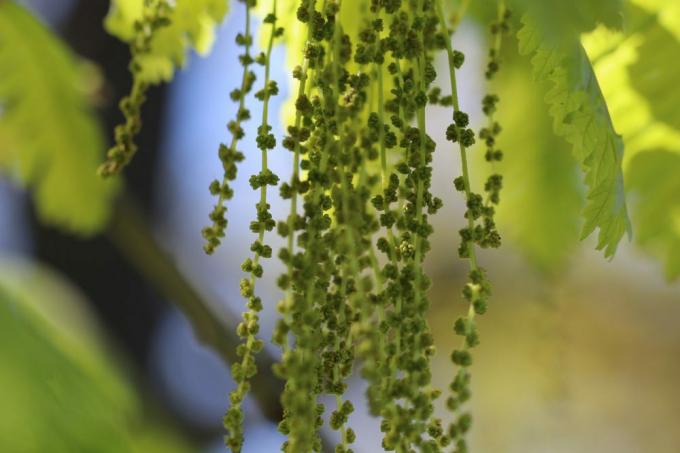
You don't have to overwinter an oak. Even when newly planted, the trees can withstand the lowest temperatures without major problems and therefore do not need any protection. In addition, as already mentioned above, the own leaves act as winter protection. While you can leave old specimens just like that, you should mulch the young trees with the oak leaves. This way you can be on the safe side, especially when a harsh winter is ahead.
Cut
Like wintering, pruning measures on an oak are actually not necessary. Oak trees do not sprout intensely in all directions and keep their shape quite well from the start. Since it grows naturally on the high trunk, you only have to remove shoots or branches that have the following growth or properties towards the end of winter:
- cross over
- crooked
- dried up
Due to the high cut tolerance, it is easy to remove. However, you should make sure that these pruning measures should mainly be carried out on a young oak tree, as it is much easier for them to recover from the pruning. In addition, it is hardly possible without professional help to remove the mostly very thick branches on the oak, let alone the dead wood that often appears with age. The older your oak, the more important it is to have it cut by a professional, otherwise you could cause irreparable damage to the tree. It is best to seek advice on this, as oaks do not have to be pruned every year when they are old.
Tip: If you keep your Quercus as a shrub or hedge, you only need to do an annual topiary in autumn. This succeeds with the least amount of effort.
Multiply
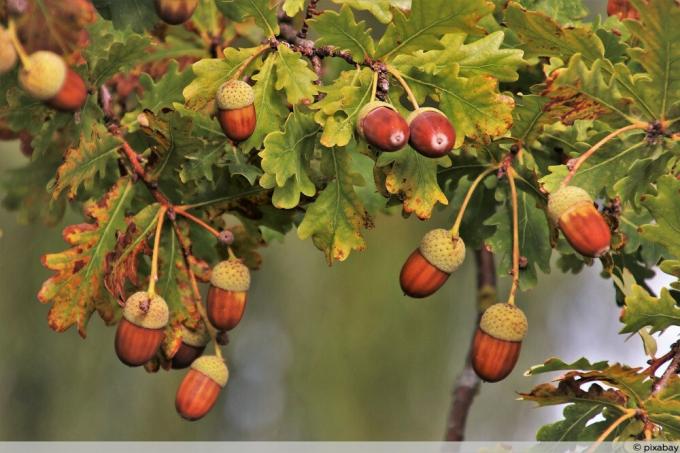
You can even use acorns from the forest or an avenue for propagation if you have collected a couple of these. Acorns that are ripe, i.e. shiny and brown in color, are best suited. Soak them in water for about twelve hours and only use the acorns that float on the surface. These are germinable. Then proceed as follows:
- Dry acorns
- Place in freezer bags
- adding some sand
- close well
- keep in refrigerator
- Duration: about 6 weeks
- Fill pots with garden soil
- Insert the acorn into this
- Depth: 2 cm
- keep it moist
- Location: bright, warm
Each acorn sprouts at a different time. If you recognize shoots, you can plant the corresponding specimens outdoors in spring. Choose the location and soil as with adult oaks.
Tip: Propagation via cuttings is also possible if the oaks are not yet seven years old. These take root best when they are grown under the polytunnel and receive a lot of moisture from the air, as the cuttings like it already moist.
Pests and diseases

If you are the owner of an oak, you will be pleased with the robust nature of the trees. An oak tree is only in the rarest of cases sick and self Pests don't appear very often if the location is right. Nevertheless, it can come from an infestation by the following pests:
- Oak gall wasp (Cynips quercusfolii): An infestation by the oak gall wasp can be seen on the galls, which are a maximum of three millimeters in size. They are located on the underside of oak leaves and rob the tree of a lot of energy.
- Oak moth (Tortrix viridana): The caterpillars of this butterfly feast on the oak leaves, which can be recognized by the damage caused by eating. If the infestation is very high, the oaks can lose all of their leaves and thereby severely weaken the oak tree.
- Oak processionary moth (Thaumetopoea processionea): These butterflies also eat the oak leaves, leaving only the middle rib standing. The infestation can severely weaken oak trees.
These can all be combated either with a brew of nettles as a spray or the use of bacteria (Bacillus thuringiensis) that let the pests perish. It is usually sufficient to distribute the bacteria once while the nettle spray is administered regularly until the infestation is contained.
It becomes dangerous when oak moths bring in powdery mildew. Powdery mildew can, in combination with the dreaded oak fire sponge (Fomitiporia robusta), a fungus, even let the tree perish. If you recognize powdery mildew on the leaves and yellow- to light-brown, sometimes red-brown, sponges protruding from the trunk, you will unfortunately have to remove the infected parts completely. These are only disposed of with residual waste. If you have many birds and beneficial insects in the garden, they will effectively act as predators against the pests.
